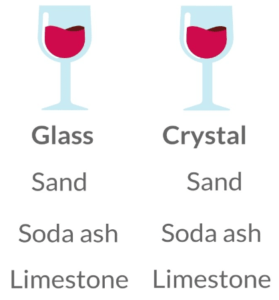
Glass is a man-made material from the combination and fusion of minerals at high temperatures, resulting in a transparent, brittle, hard, and moldable by-product.
A crystal is any solid present in nature formed from chemical processes that create a crystal lattice, which is an ordered and symmetrical structure of atoms and molecules.
The difference between glass and crystal is that glass is created with human intervention, while the crystal is a form in which the atoms and molecules of solid bodies are grouped.
Difference between Glass and Crystal in Tabular form
| Glass | Crystal | |
|---|---|---|
| Definition | Amorphous and moldable material is created from the fusion of compounds at high temperatures. | Solid material is formed from the crystallization process. |
| Source |
| It is found in nature. |
| Types |
|
|
| examples |
|
|
| how to recycle |
Glass waste goes in the green container. | If you are referring to lead glass, commonly called “crystal”, it cannot be recycled. Lead glass waste goes in the gray container. |
What is Glass?
Glass is a solid and amorphous material, created from the fusion of compounds such as silicon oxide (SiO 2 ), sodium carbonate (Na 2 CO 3 ), and calcium carbonate (CaCO 3 ), among others.
In nature, glass can be found:
- Like obsidian, a shiny, strong, sharp rock obtained by cooling volcanic lava.
- As for tactics, which are glasses from meteorites that impacted the Earth and which, due to their origin, are very rare.
The use of glass in its natural form is not as common and has been reduced to the elaboration of ornamental objects, hence man-made glass is much more popular.
On the other hand, industrial glass is classified into several types, depending on its chemical composition.
Types of glass and their uses
There are 4 types of glass, depending on the components that make it up.
Soda-lime glass
It is made up of calcium, sodium, and silica. It is very easy to melt and that is why it is the cheapest type of glass on the market.
For a long time, it was recommended to avoid soda-lime glass for the manufacture of refractory containers for gastronomic use, because it did not tolerate changes in temperature and tended to break. However, this characteristic has been modified with the incorporation of a greater amount of silica, which gives it greater resistance.
An example of soda-lime glass can be found in automobile glass.
Lead Glass
It is a glass that is made by replacing sodium and calcium with lead. It has a high meltability and expansion facility, which means that it expands when melted. It also has a refractory and UV-absorbing quality.
Lead glass is often called lead crystal, or simply, crystal. However, this is just a commercial one, as glass is not a crystalline structure, therefore there is no such thing as glass objects.
In everyday life, lead glass is present in cups, glasses, or tableware.
Borosilicate glass
It is composed of silica and boron oxide. It does not melt so easily, it has a high refractory capacity and its expansion capacity is limited, which is why it is used to make laboratory and kitchen materials since they can withstand high temperatures without expanding and without the risk of breaking due to thermal shock.
An example of the application of borosilicate glass is refractory trays and containers.
silica glass
It is the most difficult glass to melt since very high temperatures (more than 1500 °C) are required, as well as very sophisticated and expensive techniques to transform it into a final product.
Examples of silica glass can be seen in objects that require prolonged exposure to high temperatures, such as furnace linings or laboratory tubes.
What is Crystal?
The crystal is a solid, transparent structure, with an ordered, symmetrical molecular arrangement and regular geometry. It is abundant in nature and is formed from crystallization, a process in which atoms or molecules form bonds to create an elementary unit called a unit cell, a cube- or parallelepiped-shaped structure.
In everyday life, the term “crystal” is used to refer to lead glass, used in the manufacture of objects such as glasses and cups. This denomination is incorrect since glass is a material with an asymmetric and disordered molecular structure, therefore, they are two different materials.
Unit cells are classified into several groups based on their characteristics. These groups are known as crystal systems.
You may also be interested in: